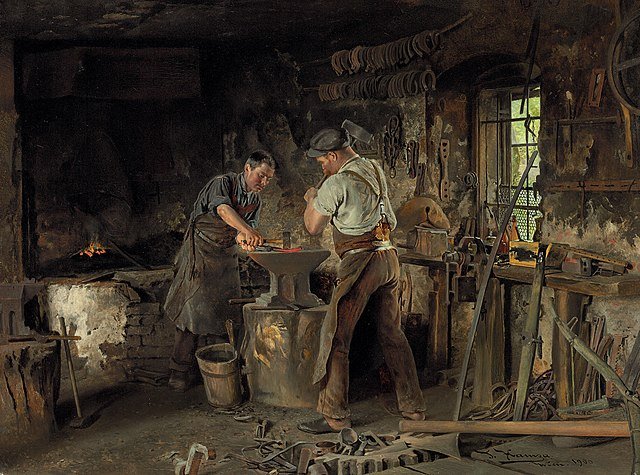Poem Time: Seamus Heaney's "The Forge"
/“All I know is a door into the dark…”
So goes the first line of “The Forge,” one of the great poems of Seamus Heaney’s early career, when he still worked mostly at the level of the individual poem; overwhelming poetic sequences like Station Island and Squarings would come later. Yet even in this early phase of his career Heaney’s poems have a certain unified feel to them. In particular, the poetry of the first few collections coalesces around the juxtaposition of natural/traditional imagery against the more abstract labors of writing. This juxtaposition lies at the center of “Digging,” the poem that launched Heaney onto the international stage and remains his best known poem to this day. But you can trace the contours of this collision in plenty of other poems - in “Personal Helicon’s” wonderful mantra “Now, to pry into roots, to finger slime/… Is beneath all adult dignity. I rhyme/ To see myself, to set the darkness echoing,” as well as in the mystic search for springs (of inspiration?) in “The Diviner".”
For my money, though, these two themes mesh best in the strange, difficult to unpack lines of “The Forge,” ostensibly a simple description of a blacksmith’s workshop, yet in the end Heaney’s most profound early meditation on the frustrations and rewards of writing. A sonnet — though, like a poem I discussed in a previous entry, Robinson Jeffers’ “Return,” an unusual sonnet — the poem survey’s the workman’s space and finds in it a fitting analog to the writer’s attempts to plumb the depths of human existence.
The juxtaposition begins in that very first line (so good that I have to quote it again): All I know is a door into the dark. As in the blacksmith’s workshop, so too in the writer’s mind — we squeeze ourselves through that narrow entry back into the impenetrable mysteries of human existence. Once in, we find evidence of the strenuous work at hand, “The unpredictable fantail of sparks” rising from the hammer’s blows on the heated iron. Lest we be too literal, Heaney guides us back: the anvil must be there somewhere, “An altar/Where he expends himself in shape and music.” This is the work of writing no less than of smithing, the desire and ability to spend oneself utterly in the effort to create “shape and music” — both correct form and the harmonic ring of a satisfying line.
What sends this poem over the top for me, though, is the recognition that such hard work requires breaks in order to come together. The smith leans against his door, observing the outside world, before returning “To beat real iron out, to work the bellows,” as the poem’s closing line puts it. In smithery of course, such rest periods are needed; not merely for the exhausted shoulder of the worker, but for the material itself to cool and take form before it gets reheated and beaten again. So too in writing, where the gaps between writing sessions matter as much as the times when words flow.
The poem is, of course, not simply a toying around with interesting ideas. It is first and foremost a poem, an example of that finished product that might emerge from the workshop still hissing with steam. And Heaney’s forgery (pardon the pun) is all over these lines, a craftsmanship evident in his proficient back and forth between convention and disruption. There’s the cheeky rhyme between lines 2 and 3, where the second rhymed word (ring) fits inside the first (rusting). There’s the clever enjambment near the end as the blacksmith “recalls a clatter/Of hoofs where traffic is flashing in rows.” Here the reader expects that the clatter the blacksmith will recall has to do with the hustle and bustle of his workplace, but instead he’s listening to the hoofbeats outside. Except, of course, that such a clatter does relate back to him; in a village setting, he’s almost certainly been the one to put those shoes on the horses’ feet. Finally, there’s the balance between power and precision which Heaney bakes into the poem in the image of the blacksmith working “with a slam and a flick,” two very distinct movements. Heaney himself, through language that oscillates between raw energy and more subtle movement, builds into his poem that hybridity of creative production he witnesses in the blacksmith. In doing so, he takes us through that door into the dark, into a place where true poetry is forged.

